A&B, EMI are seeking 30-year lease to divert water from East Maui
July 29, 2021

Alexander & Baldwin and its subsidiary East Maui Irrigation Co. have wrapped up a long-awaited environmental study that the companies need in order to seek a long-term lease to divert water from East Maui streams.
Filed last week, the final environmental impact statement is for a proposed water lease for Nahiku, Keanae, Honomanu and Huelo license areas, around 33,000 acres of state-owned land. The study is part of a process in which the companies are seeking a long-term, 30-year lease approval from the state Board of Land and Natural Resources to develop, divert, transport and use government-owned waters, along with the right to be on those state lands to perform maintenance and repairs for existing roads and trails used in connection to EMI’s aqueduct system, according to the study.
The lease would allow water to continue being delivered to Maui County Department of Water Supply customers mainly Upcountry, along with the Kula Agricultural Park, and continued delivery to the Nahiku community. It would also allow for the continued provision of water to approximately 30,000 acres of agricultural lands in Central Maui for Mahi Pono’s diversified agricultural operations, the study said.
The maximum amount of water that can be diverted while meeting the state’s requirements for stream flows within the license area is estimated to be 87.95 million gallons per day, according to the study. The EMI system also diverts an additional 4.37 mgd from the point that it leaves the license area at Honopou Stream and collects water from streams on privately owned land to its last diversion at Maliko Gulch. Of the total 92.32 mgd of surface water that would be conveyed through the system, 7.1 mgd would go toward Upcountry customers and the Kula Agricultural Park, while 85.22 mgd would be potentially available for Central Maui agricultural fields.
In October, Mahi Pono reported to the BLNR that it would need about 32.3 million gallons a day of East Maui water, largely for Central Maui farming needs.

The final version of the study comes after years of legal battles pitting Na Moku Aupuni O Ko’olau Hui, a group of taro farmers and Native Hawaiian practitioners, against A&B, the state and county over revocable water permits that were being renewed annually by the state.
East Maui taro farmers and supporters who have long criticized the permits said more than 100 years of diversions to irrigate former sugar cane fields Upcountry and in Central Maui have killed their crops and have called for studies be done on the environmental impacts of the diversions. In 2016, a bill passed by the state Legislature required lessees such as A&B to put together an environmental impact statement.
“A&B’s final EIS is long overdue,” said Ashley Obrey, a staff attorney at Native Hawaiian Legal Corporation, which has been representing the kalo farmers and Native Hawaiian practitioners in its legal challenges against A&B and the state. “We intend to take a deep dive into the document to ensure it adequately addresses our comments on the DEIS (draft environmental impact statement), complies with the letter and spirit of HRS (Hawaii Revised Statutes) chapter 343 and properly accounts for the needs of our clients and the East Maui community.”
Chapter 343 of Hawaii state law covers environmental impact statements.
In 2019, the Native Hawaiian Legal Corporation submitted a 14-page letter to the Board of Land and Natural Resources regarding its concerns on the draft EIS.
Concerns included having full disclosure of every single diversion along the EMI system, including photographs and descriptions as to how the diversion operates, as well as its precise location and how much water it diverts. Other requests included amounts of water proposed to be taken from each stream daily, maps that show every stream in East Maui, as well studies on the potential impacts of diversions on kalo growing and on flora outside of the licensed areas.
The final EIS also factors in the 2018 decision to restore 17 East Maui streams to full or near-full capacity. The state Commission on Water Resources Management established interim in-stream flow standards to protect farming, cultural practices and habitat in the area. Many of EMI’s stream diversions need to be modified to restore the streams, a requirement that needs to be met regardless of whether the companies secure a water lease.
While the proposed water lease would have a 30-year term, the commission requirement and associated benefits to the kalo growing areas, communities and environment would not be affected by the lease term, and flow standards will not change unless revised by the water commission, the final EIS said.
The study added that if the permits are granted, no significant impacts are anticipated to existing or potential future taro farming in East Maui due to the required flow standards. Taro cultivation will occur in existing/historical taro cultivation areas and not in new areas, given the barriers of terrain and economic challenges of initiating new taro farms.
The Board of Land and Natural Resources has 30 days from the date of submission to decide whether to accept the final environmental impact statement. The Land Division anticipates the BLNR will consider whether to accept it at the board’s Aug. 13 meeting.
Public testimony can be submitted and the agenda for the meeting will be posted on Aug. 6, the DLNR said in a news release.
Testimony can be sent to the Land Board secretary by fax at (808) 587-0390, Attn: Board Members; emailed to blnr.testimony@hawaii.gov; or mailed to Department of Land and Natural Resources, Attn: Board Members, 1151 Punchbowl St., Room 130, Honolulu, HI 96813.
To view the final EIS, see dlnr .hawaii.gov/ld/ab-emi-feis-for-the-proposed-lease-for-the-nahiku-keanae-honomanu-and-huelo-license-area/.
* Melissa Tanji can be reached at mtanji@mauinews.com.